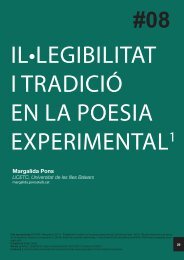03 - 452ºF
03 - 452ºF
03 - 452ºF
Create successful ePaper yourself
Turn your PDF publications into a flip-book with our unique Google optimized e-Paper software.
chick lit heroines also have a lot in common with those of Austen,<br />
whose novels also featured heroines who were beautiful but not<br />
unbelievably so, and «whose wit and good temper more than elevate<br />
[them] above [their] more glamorous but less likeable romantic rivals»<br />
(Wells, 2006: 59). Nineteenth century heroines also display an interest<br />
in fashion and their image, such as Catherine Morland in Austen’s<br />
Northanger Abbey (1818) who «lay awake [...] debating between her<br />
spotted and her tamboured muslin» (Austen, 1993: 45). They are<br />
often happiest when surrounded by their girlfriends, sharing secrets<br />
and stories, and, again in the case of Northanger Abbey, Catherine<br />
believes that friendship «is certainly the finest balm for the pangs of<br />
disappointed love» (Austen, 1993: 16). Nineteenth century heroines<br />
also often crave independence and have professional aspirations,<br />
such as in Charlotte Brontë’s Jane Eyre (1847), whose heroine has<br />
high hopes for the «promise of a smooth career» (Brontë, 1992: 94)<br />
on commencing her position as a governess. All of these traits, as<br />
well as numerous others, show an obvious link between nineteenth<br />
century women’s novels and today’s chick lit phenomenon.<br />
3. The constant criticism of women writers and their<br />
work<br />
Female writers have long experienced severe difficulty in terms of<br />
gaining recognition and respect for what they write. This tradition<br />
of criticizing women writers and their work, «and dismissing certain<br />
literary trends as feminine rubbish [...] has a history as long as the<br />
popular fiction itself» (Traister, 2005: par. 4). In fact, since the birth of<br />
the English novel in the eighteenth century, «critics moaned about the<br />
intellect-eroding effects of sentimental fiction» (Traister, 2005: par.<br />
4), and «feminist scholars have [long] been protesting the apparently<br />
systematic neglect of women’s experience in the literary canon»<br />
(Robinson, 1983: 116). In short, «the female tradition in literature has<br />
been either ignored, derided, or even [...] taken over and replaced»<br />
(Russ, 1983: 1<strong>03</strong>).<br />
There have been numerous «explanations» to justify the assumption<br />
that women’s writing was «inferior» to men’s. One such reason was<br />
related to women’s perceived limited experience in life:<br />
Vast preserves of masculine life – schools, universities, clubs, sports,<br />
businesses, government, and the army – were closed to women.<br />
Research and industry could not make up for these exclusions, and [...]<br />
women writers were at a disadvantage. [...] Since the Victorians had<br />
defined women as angelic beings who could not feel passion, anger,<br />
ambition, or honor, they did not believe that women could express more<br />
than half of life. (Showalter, 2009: 65-66)<br />
Trivial or Commendable? : Women’s Writing, Popular Culture, and Chick Lit - Mary Ryan<br />
<strong>452ºF</strong>. #<strong>03</strong> (2010) 70-84.<br />
77










